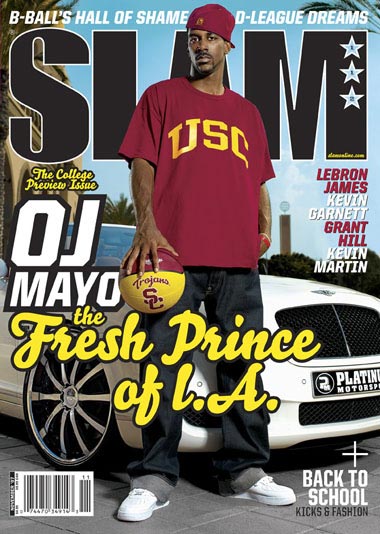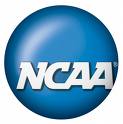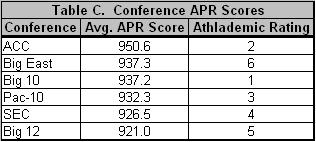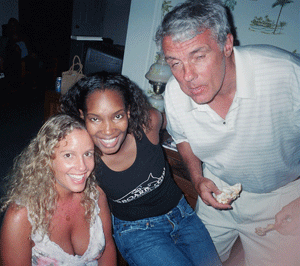Posted by nvr1983 on May 12th, 2008
I’m not even sure where to begin with this post. Here at RTC, we have discussed OJ Mayo several times most recently in what rtmsf myopically thought would be a final retrospective on the latest OJ to grace the USC campus. As pretty much everyone knows by now Mayo has been implicated in a rather large scandal involving Bill Duffy Agency (BDA) and Rodney Guillory, who appears to have been essentially hired by BDA to bring Mayo to them.
Most of my knowledge on the topic comes from Kelly Naqi’s Outside the Lines report I saw on Sunday morning while I was staying at a beach resort so this isn’t going to be some deep NY Times investigative piece that some of you may be expecting from RTC–we’ll work on that over the summer. Instead, I think it’s more interesting to consider the impact this will have on USC and recruiting/college basketball in general given the hype that Mayo brought with him to USC and the manner in which he handled his recruitment of USC–yes, the way he recruited USC.

According to the OTL report, Guillory gave Mayo cash, a flat-screen television, cell phones, hotel rooms, clothes, meals, and airline tickets. Given Mayo’s celebrity status, it’s pretty hard to believe that Tim Floyd and others at USC didn’t notice this was going on. Some prescient writers like Gregg Doyel even warned USC about the specific threat as early as 2006, but USC never did anything about it. Floyd and USC just looked the other way and hoped nobody else would notice or at least that nobody would give them up while they raked in the money from the increased attendance and sales of Mayo’s jerseys. The transgressions are not at the same level as those involving Reggie Bush’s family at USC, but these directly involved a player (Mayo) while the majority of the financial benefit in the Bush situation appears to have been reaped by Bush’s parents who stayed at a million dollar house essentially for free.
The big question now is what the NCAA will do about it. There have been several reports over the past year that the NCAA has investigated Mayo thoroughly, but did not find anything. Given the amount of evidence presented in the OTL piece, it’s hard to imagine that the NCAA spent much time digging into Mayo if they never came across any of this stuff. Ever since Yahoo! Sports broke the Reggie Bush allegations, Internet message boards have been abuzz first with what sanctions would be levied against the Trojans and when none came with conspiracy theories about how the NCAA was protecting the Trojans while being much more harsh on other teams such as a dominant football power on the East Coast (Miami). Compounding the fans fury was the seeming indifference of the sports media outside of Yahoo! Sports (read: ESPN) to really go after USC. Fans claimed that ESPN was trying to protect its sacred cow as ESPN had hyped up the Trojans to the point where they ran a week-long segment on where the Trojans ranked historically even before their Rose Bowl game against Texas, which they lost thanks to a super-human performance by Vince Young (I Heart VY). Now that ESPN has decided to join the attack against USC, it will be interesting to see if the mainstream sports media will turn up the heat on the NCAA (still waiting for the SI cover asking USC to cancel its athletic program). For those of you who think I may be going too far, the list of transgressions by USC athletes goes far beyond Bush and Mayo and includes recent charges against athletes ranging from dealing drugs to weapons possession to sexual assault.
While I’m not on board with Pat Forde’s reactionary death penalty column, I think the NCAA should come down pretty hard on USC. I am not sure what the precedent is for multi-sport probation, but given the multiple transgressions by the USC football team and the Mayo fiasco that anybody could have seen coming, its pretty clear that the Athletic Director Mike Garrett has no control over his programs or doesn’t care as long as they win. I would think that a 1- or 2-year probation with a ban on postseason play would send a pretty clear message that the NCAA won’t tolerate this kind of behavior. However, I doubt the powers that be will punish USC that severely, but USC should at least have some scholarships taken away from them in addition to the ones they lost with their poor APR performance. If the NCAA fails to do that, the Internet and the parents’ basements that bloggers inhabit will be all over them and this time the mainstream sports media with ESPN’s support will be behind them.
The story about Mayo’s recruitment is well-known as an associate of his (Guillory) entered Tim Floyd’s office and offered Mayo and his “services” to USC. When Floyd asked for Mayo’s number to speak with him, he was told that Mayo would call him. Perhaps Guillory wanted to make sure Mayo stayed within the minute limits on the plans that Guillory was paying for. Hopefully, this fiasco will convince more coaches not to get involved in these situations as it was obvious from the beginning of this relationship who was in control. At least Floyd seemed in control over the team, but it won’t be too long before some 5-star comes in with his personal coach and pushes for certain personnel moves and demands that the offense runs through him so he can get his numbers to boost his draft status.
The final issue, and potentially the most important in terms of its overall effect on college basketball, is how this will affect the NCAA’s decision on the 1-and-done rule. It’s pretty obvious that Mayo and several other stars like Michael Beasley were never going to spend a minute more than required in college before jumping to the NBA. If it’s going to be like that for the next generation of college stars, I wonder if the trade-off is worth it. As much as opposing fans like to knock Tyler Hansbrough and J.J. Redick, they embody what we used to love about the college game with guys staying 4 years and developing their games and fans identifying teams with players and not just the coaches manning the sidelines. Unfortunately, Tyler and J.J. are not the caliber of player that we saw do that in the 1980s. College hoops fans need to face the reality that we will never see a Lebron James (would have finished his senior year last year) or Dwight Howard (would have finished his senior year this year) having those kind of historic college careers. The question is how much is it worth to bring in guys of that caliber (or Mayo who is clearly several steps below James or Howard) in for 1 year with the risk of it blowing up an athletic program like it threatens to do at USC now. Mayo’s career and eventual legacy at USC may go a long way in determining the future of this rule.
| ncaa violations
| Tagged: bill duffy, bill duffy agency, death penalty, dwight howard, espn, gregg doyel, jj redick, kelly naqi, lebron james, miami, michael beasley, mike garrett, ncaa, oj mayo, outside the lines, pat forde, probation, recruiting, reggie bush, rodney guillory, sports illustrated, texas, tim floyd, tyler hansbrough, usc, vince young, violation, yahoo
Share this story

















































